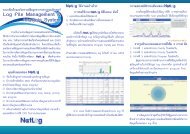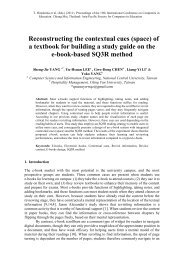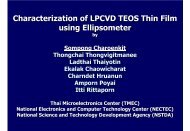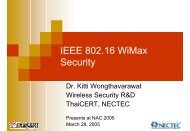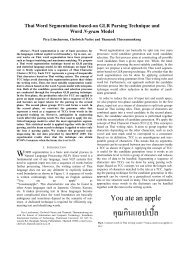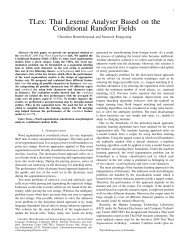DFT: Basic idea and Practical calculations
DFT: Basic idea and Practical calculations
DFT: Basic idea and Practical calculations
You also want an ePaper? Increase the reach of your titles
YUMPU automatically turns print PDFs into web optimized ePapers that Google loves.
<strong>DFT</strong>: <strong>Basic</strong> <strong>idea</strong> <strong>and</strong><br />
<strong>Practical</strong> <strong>calculations</strong><br />
APIRATH PHUSITTRAKOOL<br />
Large scale simulation research laboratory<br />
National electronics <strong>and</strong> computer technology center
How the electronic structure calculation works<br />
• Part tI: <strong>DFT</strong><br />
◦ Underst<strong>and</strong>ing the basic <strong>idea</strong>s<br />
◦ Limitationsit ti<br />
• Part II: <strong>Practical</strong> methods<br />
◦ Computational method<br />
◦ Calculation technique<br />
Apirath –<strong>DFT</strong>: basic <strong>and</strong> practice ‐ 6/5/07<br />
2
Part I outline<br />
• Cl Calculation lti of Mt Materials il<br />
• Hartree‐Fock method<br />
• Density Functional Theory<br />
• Exchange‐Correlation<br />
• Solving Kohn‐Sham equation<br />
• Force calculation<br />
• Limitation of <strong>DFT</strong><br />
Apirath –<strong>DFT</strong>: basic <strong>and</strong> practice ‐ 6/5/07<br />
3
Calculation of materials<br />
• <strong>Basic</strong> problem – many electrons in the presence of the nuclei<br />
• Fundamental Hamiltonian:<br />
Hˆ<br />
h<br />
2<br />
m<br />
2<br />
Z e<br />
r<br />
−<br />
R<br />
2<br />
I<br />
=<br />
2<br />
∑∇ − ∑ +<br />
i<br />
i<br />
i,<br />
I<br />
i<br />
I<br />
1<br />
2<br />
∑<br />
i,<br />
j<br />
r<br />
i<br />
e<br />
2<br />
−<br />
r<br />
j<br />
electronic<br />
part<br />
−<br />
2<br />
h<br />
2<br />
+ 1 Z<br />
I<br />
Z<br />
Je<br />
M<br />
∑∇I<br />
∑<br />
2 2<br />
R −<br />
R<br />
M I<br />
I , J<br />
I<br />
2<br />
J<br />
• Born‐Oppenheimer approximation<br />
◦ Nuclei are fixed – neglect the kinetic term of nuclei<br />
◦ The last term is a constant added to the electronic part<br />
Apirath –<strong>DFT</strong>: basic <strong>and</strong> practice ‐ 6/5/07<br />
4
Many‐body y interacting electron problem<br />
• Schrödinger equation for many electron sstem system<br />
Hˆ<br />
Ψ(<br />
r<br />
, r<br />
, K,<br />
r<br />
)<br />
= EΨ(<br />
r<br />
, r<br />
, K,<br />
r<br />
1 2 N<br />
1 2 N<br />
)<br />
• If we could solve the Schrödinger equation, we could predict the<br />
behavior of any electronic system<br />
• Many electron wave functions Ψ(r 1 , r 2 , …, r N ) is a function of 3N<br />
variables, where N is the number of electron<br />
• Too many degree of freedom Can’t be solved<br />
Apirath –<strong>DFT</strong>: basic <strong>and</strong> practice ‐ 6/5/07<br />
5
Approaching to many‐body y problem<br />
• Hartree‐Fock<br />
◦ Independent electron approximation<br />
• Density Functional Theory<br />
◦ Consider electron density instead of the wavefunction<br />
• Quantum Monte Carlo<br />
◦ Statistical method<br />
Apirath –<strong>DFT</strong>: basic <strong>and</strong> practice ‐ 6/5/07<br />
6
Hartree approximation<br />
• Neglecting the correlation – assumes the electrons are<br />
uncorrelated<br />
• Total wave function is written as the product of single electron<br />
wave functions<br />
Ψ(<br />
r , r<br />
(<br />
1 2,<br />
K , rN<br />
) = ψ<br />
1<br />
( r1<br />
), ψ<br />
2<br />
( r2<br />
) Kψ<br />
N<br />
( rN<br />
)<br />
• Variational principle leads to Hartree equation<br />
1<br />
2<br />
2<br />
[ − ∇i<br />
+ Vion<br />
+ VH<br />
V<br />
H<br />
(<br />
j<br />
ri<br />
) = 2∑ ∫ j ≠<br />
i r −<br />
( r<br />
ψ ( r<br />
j<br />
i<br />
r i r<br />
)] ψ ( r ) = ε ψ ( r )<br />
)<br />
j<br />
2<br />
i<br />
dr<br />
j<br />
i<br />
i<br />
i<br />
i<br />
Hartree potential,<br />
average Coulomb potential<br />
from other electrons<br />
Apirath –<strong>DFT</strong>: basic <strong>and</strong> practice ‐ 6/5/07<br />
7
Hartree‐Fock (HF)<br />
• Electrons are fermions; obey the Pauli ecl exclusion sionprinciple <strong>and</strong><br />
Fermi statistics<br />
◦ Wave function changes sign when the coordinates of two electrons are<br />
interchanged<br />
◦ Wave function is zero if two electrons are in the same state<br />
◦ Wave function is written to be an antisymmtrized product (l (Slater Determinant)<br />
Ψ =<br />
ψ<br />
1<br />
(<br />
r<br />
1<br />
)<br />
ψ<br />
1<br />
(<br />
r<br />
2<br />
) L<br />
ψ<br />
1<br />
(<br />
r<br />
ψ ( r ) ψ ( r ) L ψ ( r<br />
1 N<br />
1 2 1 2 2<br />
2<br />
N<br />
!<br />
M<br />
M<br />
O<br />
M<br />
ψ ( r ) ψ ( r ) L ψ ( r<br />
N<br />
1 N 2<br />
N N<br />
N<br />
)<br />
)<br />
)<br />
Apirath –<strong>DFT</strong>: basic <strong>and</strong> practice ‐ 6/5/07<br />
8
Exchange interaction<br />
• Minimize the energy with respect to Slater determinant leads to<br />
the Hartree‐Fock equations<br />
1<br />
2<br />
[ − ∇i<br />
+ Vion<br />
+ VH<br />
( ri<br />
) + VX<br />
2<br />
V<br />
X<br />
( r<br />
i<br />
)<br />
⎡<br />
= ∑ ∫<br />
1<br />
−<br />
⎢<br />
2<br />
⎣⎢<br />
j<br />
*<br />
ψ<br />
(<br />
r<br />
j<br />
r<br />
i<br />
j<br />
( r<br />
i<br />
)<br />
ψ<br />
(<br />
r<br />
)] ψ ( r ) = ε ψ ( r )<br />
i<br />
r<br />
j<br />
j<br />
i<br />
i<br />
)<br />
dr<br />
j<br />
⎤<br />
ψ<br />
j<br />
(<br />
r<br />
i<br />
)<br />
⎥<br />
⎥ ψ<br />
i(<br />
ri<br />
)<br />
⎦<br />
• Adding Fermionic nature of electrons to the Hartree method give<br />
rise to an effective potential called exchange interaction<br />
• still neglect the correlation effect, so large deviation from the<br />
experiment results<br />
−<br />
i<br />
i<br />
i<br />
Apirath –<strong>DFT</strong>: basic <strong>and</strong> practice ‐ 6/5/07<br />
9
Density Functional Theory (<strong>DFT</strong>)<br />
• Hohenberg‐Kohn‐Sham proposed a new approach to the manybody<br />
interacting electron problem<br />
• All ground state tt properties are dt determined dby the ground state tt<br />
density<br />
• Hohenberg‐Kohn h theorems(1964)<br />
◦ Two statements constitute the basis of <strong>DFT</strong><br />
◦ Do not offer a way of computing in practice<br />
• Kohn‐Sham ansatz (1965)<br />
◦ Turn <strong>DFT</strong> into practical method<br />
Apirath –<strong>DFT</strong>: basic <strong>and</strong> practice ‐ 6/5/07<br />
10
Hohenberg‐Kohn theorem<br />
• Theorem I: density as a basic variable<br />
• The total energy of a many‐body system is a unique functional of<br />
electron density<br />
• The total energy functional can be written as<br />
E n]<br />
= F[<br />
n]<br />
+ v ( r)<br />
n(<br />
r)<br />
dr<br />
∫<br />
[<br />
ext interaction with nuclei<br />
<strong>and</strong> any other field<br />
• Universal functional F[n] isindependentindependent of external potential –<br />
but unknown!<br />
F [ n<br />
] =<br />
T<br />
[<br />
n<br />
]<br />
+<br />
U<br />
[<br />
n<br />
]<br />
Apirath –<strong>DFT</strong>: basic <strong>and</strong> practice ‐ 6/5/07<br />
11
Hohenberg‐Kohn theorem<br />
• Theorem II: variational for the energy in term of density<br />
• The functional E[n(r)] has its minimum when electron density is<br />
at the equilibrium electron density n 0 (r)<br />
• The minimum of the energy E 0 is exactly equivalent to the true<br />
ground‐state energy<br />
E<br />
≡<br />
min E[<br />
n(<br />
r)]<br />
≡ E[<br />
n0<br />
(<br />
0<br />
r<br />
)]<br />
Apirath –<strong>DFT</strong>: basic <strong>and</strong> practice ‐ 6/5/07<br />
12
The Kohn‐Sham ansatz<br />
• Replace original many‐body problem with an independent<br />
electron problem that can be solved<br />
• The unknown functional F[n] is cast in the form<br />
n(<br />
r)<br />
n(<br />
r'<br />
)<br />
F[ n]<br />
= Ts [ n]<br />
+<br />
∫ drdr'<br />
+ Exc[<br />
n]<br />
r −<br />
r<br />
'<br />
• T s [n] –non‐interacting kinetic energy<br />
2<br />
h<br />
* 2<br />
Ts [ n]<br />
= ∑ i<br />
( r)<br />
i<br />
( r)<br />
dr<br />
2m<br />
∫ ψ ∇ ψ<br />
• Put tthe rest unknown into E xc [n]<br />
• Exact theory but unknown functional E xc [n]<br />
i<br />
Apirath –<strong>DFT</strong>: basic <strong>and</strong> practice ‐ 6/5/07<br />
13
Exchange‐correlation functional<br />
• Exchange<br />
◦ Keep electrons of same spin away from each other (Pauli exclusion)<br />
• Correlation<br />
◦ Keep electrons away from each other due to Coulombic forces<br />
• Finding E xc functional lis the great challenge, hll but approximate<br />
functionals work:<br />
◦ LDA<br />
◦ GGA<br />
◦ Hybrid functional<br />
◦ EXX<br />
Apirath –<strong>DFT</strong>: basic <strong>and</strong> practice ‐ 6/5/07<br />
14
Local (Spin) (p Density Approximation L(S)DA ()<br />
• The simplest but tsurprisingly good approximation<br />
• Assume that the charge density varies slowly; each small volume<br />
looks like a uniform electron gas<br />
• E xc [n] can be obtained by integrating uniform e ‐ gas results<br />
E<br />
∫<br />
[ n]<br />
= n(<br />
r)<br />
ε ( n d r<br />
LDA<br />
xc xc<br />
)<br />
◦ ε xc (n) is the exchange‐correlation energy per electron in homogenous electron<br />
gas at density n, which can be calculated<br />
• More generally, formulation for spin density<br />
E<br />
∫<br />
LSDA<br />
xc<br />
[ n , n ] = n(<br />
r)<br />
ε n n dr<br />
↑ ↓<br />
xc(<br />
, )<br />
↑ ↓<br />
Apirath –<strong>DFT</strong>: basic <strong>and</strong> practice ‐ 6/5/07<br />
15
Generalized‐Gradient Approximation (GGA)<br />
• Density gradient epansion expansion<br />
• Take the value of the density at each point as well as the<br />
magnitude of the gradient of the density<br />
∫<br />
E<br />
GGA [ n<br />
]<br />
= n<br />
(<br />
r<br />
)<br />
ε<br />
(<br />
n,<br />
∇<br />
n)<br />
d<br />
r<br />
xc xc<br />
)<br />
• Make aeimprovement poe e toe over LDA for many ycases<br />
◦ E.g. improve predicted binding <strong>and</strong> dissociation energies<br />
Apirath –<strong>DFT</strong>: basic <strong>and</strong> practice ‐ 6/5/07<br />
16
Hybrid functional<br />
• Combination of orbital‐dependent HF <strong>and</strong> an explicit density<br />
functional (LDA/GGA)<br />
• The most accurate functionals available (as far as energetic is<br />
concerned)<br />
• The method of choice in chemistry<br />
• Example:<br />
half 1 HF<br />
E = ( E +<br />
xc<br />
2<br />
x<br />
E<br />
DF<br />
xc<br />
)<br />
E = (1 − a)<br />
E + aE + bE + cE + (1 − c)<br />
E<br />
B3LYP<br />
xc<br />
LDA<br />
xc<br />
HF<br />
x<br />
Becke<br />
x<br />
LYP<br />
c<br />
VWN<br />
c<br />
Apirath –<strong>DFT</strong>: basic <strong>and</strong> practice ‐ 6/5/07<br />
17
Orbital functionals ‐ OEP<br />
• Functional explicitly dependence on orbitals<br />
• Optimized effective potential method (OEP) allows orbital<br />
dependent d tfunctionals to be used in <strong>DFT</strong><br />
• The most common approach is to evaluate the HF exchange<br />
energy within ihi KS orbitals , exact exchange (EXX), <strong>and</strong> solve using<br />
OEP<br />
• Typically, OEP‐EXX methods have much better b<strong>and</strong> gaps<br />
• But the computational cost of solving the OEP is a major<br />
drawback<br />
Apirath –<strong>DFT</strong>: basic <strong>and</strong> practice ‐ 6/5/07<br />
18
Kohn‐Sham equations<br />
• Kohn‐Sham energy functional:<br />
E<br />
n]<br />
n(<br />
r)<br />
n(<br />
r'<br />
)<br />
= Ts [ n]<br />
+ ∫ drdr'<br />
+ Exc[<br />
n]<br />
+<br />
−<br />
∫ v ( r)<br />
n(<br />
r)<br />
dr<br />
r<br />
r'<br />
[<br />
ext<br />
• Minimizing the energy functional leads to the Kohn‐Sham<br />
equations (Schrödinger equations of single electron in effective<br />
potential)<br />
⎡<br />
⎢−<br />
⎣<br />
2<br />
h<br />
2m<br />
∇<br />
2<br />
+<br />
V<br />
eff<br />
⎤<br />
(<br />
r<br />
)<br />
⎥ ψ i<br />
(<br />
r<br />
) =<br />
⎦<br />
ε ψ<br />
(<br />
r<br />
)<br />
V ( r<br />
)<br />
=<br />
V<br />
(<br />
r<br />
)<br />
+<br />
V<br />
(<br />
r<br />
)<br />
+<br />
V<br />
(<br />
r<br />
)<br />
eff<br />
(<br />
ext<br />
H<br />
xc<br />
i<br />
i<br />
∑<br />
n( r)<br />
ψ ( r)<br />
=<br />
i<br />
i<br />
2<br />
Apirath –<strong>DFT</strong>: basic <strong>and</strong> practice ‐ 6/5/07<br />
19
Solving Kohn‐Sham equation<br />
• Because the effective potential ti lVV eff depends d upon n(r), ( ) <strong>and</strong><br />
hence ψ(r), which is the solution of the equation<br />
V eff<br />
n(r)<br />
ψ(r)<br />
• The Kohn‐Sham equations must be solved by an iterative<br />
technique; self‐consistent field method<br />
Apirath –<strong>DFT</strong>: basic <strong>and</strong> practice ‐ 6/5/07<br />
20
Self‐consistent calculation procedure<br />
Guess density n(r)<br />
Construct effective potential<br />
V<br />
eff<br />
( r)<br />
= Vext<br />
( r)<br />
+ VH[<br />
n]<br />
+ Vxc[<br />
n]<br />
2<br />
⎡<br />
⎢− h<br />
⎣<br />
2m<br />
∇<br />
Solve KS equation<br />
2<br />
+ V<br />
eff<br />
⎤<br />
( r<br />
)<br />
⎥ ψ<br />
( r<br />
) = i<br />
⎦<br />
ε<br />
ψ<br />
( r<br />
)<br />
i<br />
i<br />
Calculate new density <strong>and</strong> Compare<br />
∑<br />
n( r)<br />
= ψ ( r)<br />
i<br />
i<br />
2<br />
no<br />
Selfconsistent<br />
Total energy, Force,<br />
yes<br />
Obtain output:<br />
? Eigenvalues, …<br />
Apirath –<strong>DFT</strong>: basic <strong>and</strong> practice ‐ 6/5/07<br />
21
Output from KS equations<br />
• We have solved the Kohn‐Sham equations <strong>and</strong> found the eigenenergies<br />
<strong>and</strong> eigen‐functions, what next?<br />
• We can obtained<br />
◦ Ground state total energy<br />
◦ Forces acting on atom<br />
◦ Charge density<br />
◦ B<strong>and</strong> structure <strong>and</strong> density of states<br />
◦ Vibrational properties<br />
Apirath –<strong>DFT</strong>: basic <strong>and</strong> practice ‐ 6/5/07<br />
22
Kohn‐Sham eigenvalues <strong>and</strong> orbitals<br />
• Kohn‐Sham eigenvalues <strong>and</strong> orbitals have no physical meaning<br />
• Only the ground state density <strong>and</strong> total energy can be trusted<br />
• Except only highest occupied KS eigenvalues has a meaning as<br />
the first ionization i energy (but only for exact functional)<br />
• There is no straightforward relationship between KS eigen‐<br />
energies <strong>and</strong> the excitation i energy of quasiparticles<br />
i • But many b<strong>and</strong>‐structure <strong>calculations</strong> in solid state physics is<br />
from KS eigenvalues<br />
Apirath –<strong>DFT</strong>: basic <strong>and</strong> practice ‐ 6/5/07<br />
23
Hellmann‐Feynman theorem: forces <strong>and</strong> stress<br />
• Forces acting on ions can be ealatedanal evaluated analytically<br />
F<br />
I<br />
=<br />
− ψ<br />
∂H<br />
∂RR<br />
I<br />
• This formula correct for position independent basis <strong>and</strong><br />
complete basis set<br />
• Forces are very sensitive to errors in total energy; the ground<br />
state must be determined very accurately<br />
• This theorem can also be applied for stress on unit cells<br />
σ<br />
αβ<br />
ψ<br />
∂H<br />
= − ψ ψ<br />
derivative energy with<br />
∂t<br />
αβ<br />
respect to strain tensor<br />
Apirath –<strong>DFT</strong>: basic <strong>and</strong> practice ‐ 6/5/07<br />
24
The accuracy of <strong>DFT</strong><br />
• Molecular lar structures<br />
res<br />
◦ bond lengths are accurate to within 1‐2%<br />
• Vibrational frequencies<br />
◦ within 5‐10% accuracy<br />
• Atomization energies<br />
◦ LDA < GGA < hybrid<br />
◦ desired accuracy for hybrid functionals<br />
• Ionization <strong>and</strong> affinity energies<br />
◦ Average error around 0.2 eV for hybrid functionals<br />
Apirath –<strong>DFT</strong>: basic <strong>and</strong> practice ‐ 6/5/07<br />
25
Limitations of <strong>DFT</strong><br />
• B<strong>and</strong>‐gap problem<br />
◦ HKS theorem is not valid for excited states<br />
◦ B<strong>and</strong> gap in semiconductors <strong>and</strong> insulators are always underestimated<br />
◦ EXX <strong>and</strong> hybrid functionals lead to better gaps<br />
• Overbinding<br />
◦ LSDA <strong>calculations</strong> usually give too large cohesive energies, too high bulk<br />
moduli<br />
◦ GGA largely correct overbinding<br />
◦ The use of the GGA is m<strong>and</strong>atory for calculating adsorption energies<br />
Apirath –<strong>DFT</strong>: basic <strong>and</strong> practice ‐ 6/5/07<br />
26
Limitations of <strong>DFT</strong><br />
• Difficulty in strong correlations<br />
◦ No one knows a feasible approximation valid for all problems – especially for<br />
cases with strong electron‐electron correlation<br />
• Neglect of van‐der‐Waals interactions<br />
◦ Not included in any <strong>DFT</strong> functional<br />
◦ Possible solution – approximate expression of dipole‐dipole vdW forces on<br />
the basis of local polarizabilities derived from <strong>DFT</strong><br />
Apirath –<strong>DFT</strong>: basic <strong>and</strong> practice ‐ 6/5/07<br />
27
Summary<br />
• Calculation lation of electronic structure re of materials by solving manyelectron<br />
problem need approximations<br />
• HF – neglect electron correlation lead to large deviations from<br />
the experiment results<br />
• <strong>DFT</strong> – no attempt to compute many‐body wave function, instead<br />
energy is written in term of the electron density<br />
• KS – treat the kinetic energy properly, p bring back the wave<br />
function<br />
• E xc – approximation forms have proved to be very successful, but<br />
xc<br />
there are failures<br />
• Requires care <strong>and</strong> underst<strong>and</strong>ing of limitation of the functionals<br />
Apirath –<strong>DFT</strong>: basic <strong>and</strong> practice ‐ 6/5/07<br />
28
Part II outline<br />
• Periodic solid <strong>and</strong> Bloch’s theorem<br />
• Basis set<br />
• Plane wave method<br />
• Pseudopotential<br />
• Brillouin zone integration<br />
• Some practical aspect<br />
Apirath –<strong>DFT</strong>: basic <strong>and</strong> practice ‐ 6/5/07<br />
29
Finite vs. Extended systems<br />
• Finite it system<br />
◦ Atom, molecules, clusters<br />
◦ Boundary is open<br />
◦ Discrete energy level<br />
• Et Extended ddsystem<br />
◦ Crystal, surface, …<br />
◦ Boundary condition is normally periodic<br />
◦ Lead to continuous b<strong>and</strong><br />
Apirath –<strong>DFT</strong>: basic <strong>and</strong> practice ‐ 6/5/07<br />
30
Periodic solids<br />
• Crystal structures res = Infinite repeated unit cell<br />
• Real (direct) space<br />
◦ Bravais lattice:<br />
R<br />
• Reciprocal space<br />
◦ Reciprocal lattice:<br />
=<br />
n a<br />
+<br />
n<br />
a<br />
+<br />
n<br />
G<br />
1 1 2 2 3<br />
a3<br />
=<br />
g +<br />
◦ where real space <strong>and</strong> reciprocal<br />
space are related by<br />
e<br />
iG⋅R<br />
2π<br />
= 1 ⇒ b1=<br />
a2<br />
× a<br />
Ω<br />
• 1 st Brillouin zone (BZ)<br />
◦ primitive cell of reciprocal lattice<br />
1 b<br />
1<br />
+<br />
g<br />
2<br />
b<br />
2<br />
g<br />
3<br />
b<br />
3<br />
3<br />
Apirath –<strong>DFT</strong>: basic <strong>and</strong> practice ‐ 6/5/07<br />
31
Bloch’s theorem<br />
• Bloch’s theorem: The density is periodic so the wave aefunction is<br />
ψ ( r)<br />
= u n (r) exp( ik<br />
⋅ r)<br />
n<br />
k<br />
◦ The function u(r) has the periodicity of the unit cell<br />
◦ Wave function is repeat with a change of phase<br />
• Imply that it suffices to calculate ψ kn in just one unit cell<br />
k<br />
• All possible states tt are specified by wave vector k within the BZ<br />
<strong>and</strong> b<strong>and</strong> index n<br />
• The eigenvalues ε(n,k) ( become continuous b<strong>and</strong>s<br />
Apirath –<strong>DFT</strong>: basic <strong>and</strong> practice ‐ 6/5/07<br />
32
B<strong>and</strong> structure<br />
• The whole electronic structure of periodic crystal are represented by<br />
the b<strong>and</strong> structure<br />
The b<strong>and</strong> structure plot<br />
shows ε(n,k) only along<br />
the high symmetry<br />
directions in the BZ<br />
1 st Brillouin zone of FCC<br />
Apirath –<strong>DFT</strong>: basic <strong>and</strong> practice ‐ 6/5/07<br />
33
Modeling non periodic system<br />
• Molecule, cluster, defect, surface, …<br />
• As almost all plane wave codes impose<br />
periodic boundary conditions, the<br />
calculation of non‐periodic system must<br />
be performed using ’supercell approach’<br />
• The interaction between repeated images<br />
must be h<strong>and</strong>led by a sufficiently large<br />
vacuum region<br />
• For surface calculation, the thickness of<br />
the slab must be large enough<br />
Apirath –<strong>DFT</strong>: basic <strong>and</strong> practice ‐ 6/5/07<br />
34
Basis function<br />
• Exp<strong>and</strong> wave function on the basis function<br />
◦ We want to find the coefficients c i<br />
∑<br />
ψ ( r)<br />
= c φ ( r)<br />
◦ Diagonalize H matrix to find the eigenvalues <strong>and</strong> eigenfunctions<br />
• There are three basic approaches to the calculation of<br />
independent‐particle electronic states in materials<br />
◦ Plane waves<br />
◦ Localized atomic orbitals<br />
◦ Augmented methods<br />
• Each method has its advantages <strong>and</strong> pitfalls<br />
i<br />
i<br />
i<br />
Apirath –<strong>DFT</strong>: basic <strong>and</strong> practice ‐ 6/5/07<br />
35
Plane wave<br />
• Wave functions are written as sum mof plane waves aes<br />
iG1⋅r<br />
iG<br />
2 ⋅r<br />
iG3<br />
ψ<br />
( r ) =<br />
c<br />
e<br />
+<br />
c<br />
e<br />
+<br />
c<br />
e<br />
i<br />
r 1<br />
2<br />
3<br />
⋅r<br />
+ K<br />
• Historical reason: related to free electron picture for metal<br />
• Perfect for crystals (periodic systems)<br />
• Simple to implement<br />
• Calculation is simplicity <strong>and</strong> efficiency using FFT’s<br />
Apirath –<strong>DFT</strong>: basic <strong>and</strong> practice ‐ 6/5/07<br />
36
Pros <strong>and</strong> Cons of the plane wave basis set<br />
• Pros<br />
◦ Plane wave basis set is complete <strong>and</strong> unbiased<br />
◦ There is single convergence criterion<br />
i<br />
◦ Plane waves are mathematical simple, <strong>and</strong> their derivatives are<br />
product in k‐space<br />
◦ Plane waves do not depend on the atomic positions (force do not<br />
depend on the basis set; no Pulay forces)<br />
• Cons<br />
◦ The number of plane waves needed is quite large<br />
◦ Empty space is included in the calculation<br />
Apirath –<strong>DFT</strong>: basic <strong>and</strong> practice ‐ 6/5/07<br />
37
Localized atomic orbital<br />
• Wave function are written as sum of atomic‐like orbitals (s, p, d, f)<br />
ψ<br />
i<br />
( r)<br />
1<br />
2<br />
3<br />
2<br />
= c 1s<br />
+ c 2s<br />
+ c p<br />
+ K<br />
• Advantage<br />
◦ The intuitive appeal of atomic‐like states<br />
◦ Gaussian basis widely used in chemistry<br />
◦ Simplest interpretation in tight‐bind form<br />
◦ Small basis sets are required<br />
• Disadvantage<br />
◦ Non orthogonal<br />
◦ Depend on atomic position<br />
◦ Basis set super position errors (BSSE)<br />
Apirath –<strong>DFT</strong>: basic <strong>and</strong> practice ‐ 6/5/07<br />
38
Augmented Plane Wave (APW)<br />
• Partition space into space around each atom <strong>and</strong> interstitial<br />
region<br />
◦ Wave function outside sphere represent with plane wave<br />
◦ Wave function inside sphere represent with spherical harmonic functions<br />
plane waves<br />
spherical<br />
harmonics<br />
• Best of both region<br />
• Require matching inside <strong>and</strong> outside functions<br />
Apirath –<strong>DFT</strong>: basic <strong>and</strong> practice ‐ 6/5/07<br />
39
Pseudopotential approximation<br />
• For the plane wave aebasis set, the number mberof plane waves aeswould<br />
be very large (>10 6 )<br />
◦ Valence‐electron electron wave function is far from free‐electron electron like near atomic cores<br />
◦ The valence‐electron wave functions vary rapidly because the requirement for<br />
orthogonal to core‐electron wave functions<br />
◦ Core‐electron wave functions are localized<br />
li • To make plane wave basis set feasible; pseudopotential instead<br />
of exact pseudopotential must be applied<br />
• Why pseudopotential approximation work:<br />
◦ Only valence electrons participate in chemical bonding <strong>and</strong> core electrons are<br />
almost unaffected<br />
◦ The detail of valence wave functions near the atomic nuclei is unimportant<br />
Apirath –<strong>DFT</strong>: basic <strong>and</strong> practice ‐ 6/5/07<br />
40
Pseudopotential concept<br />
• Replace nucleus <strong>and</strong> core electrons by a fixed effective potential<br />
• Only valence electrons are taken into account in the calculation<br />
• Remove core state tt from the spectrum<br />
occupation, eigenvalues<br />
3p 1 ‐2.7 27eV valence<br />
2p<br />
1 ‐2.7 27eV<br />
3s 2 ‐7.8 eV states 1s 2 ‐7.8 eV<br />
2p<br />
6 ‐69.8 eV<br />
2s 2 ‐108 eV core<br />
states<br />
pseudo atom<br />
Z = 3<br />
1s<br />
2 ‐1512 eV<br />
1<br />
1<br />
− ∇ + V ) ψ = ε ψ − ∇<br />
2 2<br />
+ V<br />
) ψ = ε<br />
2 2 (ps) (ps) (ps) (ps)<br />
(<br />
eff i i i<br />
(<br />
eff eff i i<br />
ψ<br />
Apirath –<strong>DFT</strong>: basic <strong>and</strong> practice ‐ 6/5/07<br />
41
Pseudopotential generation<br />
ψ<br />
AE<br />
l<br />
⇒ ψ<br />
PS<br />
l<br />
⇒<br />
V<br />
PS<br />
l<br />
1. Calculate exact all electron wave functions for a reference atom<br />
2. Replace the exact wave function by a node less pseudo‐wave function<br />
3. Invert Schrödinger equation to obtain the pseudopotential<br />
• Pseudopotentials must conserve exactly the scattering properties of<br />
the original atom in the atomic configuration<br />
• Pseudopotentials must be generated with the same functional that will<br />
be later used in <strong>calculations</strong>.<br />
• Choice of pseudopotential is not unique; lot of freedom to construct<br />
Apirath –<strong>DFT</strong>: basic <strong>and</strong> practice ‐ 6/5/07<br />
42
Transferability <strong>and</strong> softness<br />
• Transferability: a pseudopotential such chthat can be used in<br />
whatever environment (molecule, cluster, solid, surface,<br />
insulator, metal, …) is called transferable<br />
• Softness: a pseudopotential is called soft when a few plane<br />
waves are needed<br />
◦ Ultrasoft means very small amount of plane waves needed<br />
• The art of creating good pseudopotential is to find one that are<br />
both (ultra)soft <strong>and</strong> transferable<br />
Apirath –<strong>DFT</strong>: basic <strong>and</strong> practice ‐ 6/5/07<br />
43
Norm‐conserving pseudopotential<br />
p<br />
• The pseudo‐wave aefunctions, generally, do not have the same<br />
norm as the all electron wave functions inside the spheres<br />
• Obviously, one would like to get integrating ti the charge in the<br />
core region the same as the all‐electron one<br />
R c R c<br />
PS<br />
2<br />
AE<br />
2<br />
∫ ψ ( r)<br />
dr<br />
= ∫ ψ ( r)<br />
dr<br />
0<br />
• Key step to improve the accuracy, transferable of<br />
pseudopotentials<br />
• But not so soft as we desired (especially, first row elements <strong>and</strong><br />
transition metals)<br />
0<br />
Apirath –<strong>DFT</strong>: basic <strong>and</strong> practice ‐ 6/5/07<br />
44
Ultrasolft pseudopotential<br />
p<br />
• Relaxing the norm‐conservation constraint for the valence wave ae<br />
function <strong>and</strong> put more complexity in the core<br />
• Dfi Define an (smooth) auxiliary wave function add to plane wave<br />
around each atom<br />
• Can make as soft as desired dbecause norm‐conservation is not<br />
required<br />
◦ Basis sets are roughly a factor 2‐3 smaller<br />
◦ Accuracy can be better than norm‐conserving pseudopotential<br />
• Closely l relate (approximation) to projector augmented wave<br />
method (PAW), which is as accurate as an all electron method<br />
Apirath –<strong>DFT</strong>: basic <strong>and</strong> practice ‐ 6/5/07<br />
45
Projector augmented wave (PAW)<br />
• Combination of the pseudopotential approach <strong>and</strong> the<br />
augmented wave method<br />
~<br />
ψ =<br />
~<br />
ψ<br />
+<br />
(<br />
φ −<br />
~<br />
~<br />
m<br />
φm)<br />
pm<br />
ψ<br />
∑<br />
m<br />
• Better method than pseudopotential<br />
◦ Total density of the system is computed; no transferability problem<br />
◦ Plane wave cutoff is equivalent to ultrasoft<br />
◦ PAW method is as accurate as all an electron method<br />
Apirath –<strong>DFT</strong>: basic <strong>and</strong> practice ‐ 6/5/07<br />
46
Pseudopotential conclusion<br />
• Use PAW or ultrasoft whenever possible<br />
◦ but it is not available in every code<br />
• Use provided pseudopotentials<br />
◦ almost plane wave codes come with well tested pseudopotential databases<br />
◦ create one by yourself is not a good <strong>idea</strong>, but you may have to<br />
• Always test your pseudopotentials<br />
Apirath –<strong>DFT</strong>: basic <strong>and</strong> practice ‐ 6/5/07<br />
47
Plane wave cutoff<br />
• Wave functions are written as sum mof plane waves aes<br />
ψ<br />
n, k<br />
( r)<br />
◦ G is reciprocal lattice vectors<br />
=<br />
∑<br />
c<br />
G<br />
e<br />
i(<br />
k+<br />
G)<br />
⋅r<br />
• In principle, i infinite it number of plane waves are required<br />
• In practice, the number of plane waves is determined by<br />
the cutoff kinetic energy E cut<br />
G<br />
◦ Only reciprocal lattice vectors satisfied following condition are included in expansion<br />
k + G<br />
2<br />
≤ E cut<br />
• The quality of the plane wave basis set depend on this cutoff<br />
Apirath –<strong>DFT</strong>: basic <strong>and</strong> practice ‐ 6/5/07<br />
48
Plane wave cutoff<br />
2G cut<br />
The radius of the<br />
sphere is proportional<br />
to the square root of<br />
the cutoff energy<br />
G cut<br />
Twice cutoff radius<br />
is needed for<br />
density expansion<br />
b 2<br />
reciprocal space<br />
b 1<br />
• Only reciprocal lattices inside the sphere are used in expansion<br />
• Basis set size is depend on cutoff <strong>and</strong> volume of box only<br />
Apirath –<strong>DFT</strong>: basic <strong>and</strong> practice ‐ 6/5/07<br />
49
Convergence test<br />
• E cut control the completeness of<br />
the basis set<br />
• Truncation of basis set will lead<br />
to an error<br />
• Reduce the error by increasing<br />
the value of cutoff energy<br />
• Always check the convergence of<br />
physical properties against E cut<br />
50<br />
Apirath –<strong>DFT</strong>: basic <strong>and</strong> practice ‐ 6/5/07
Fast Fourier Transform (FFT)<br />
• FFT is essential for efficiency:<br />
◦ Transforming the wave functions <strong>and</strong> density between real <strong>and</strong> reciprocal space<br />
◦ eg e.g., V(r)ψ(r): convolution in G‐space scale as Nlog(N) instead of N 2 for a direct<br />
computation<br />
V ( r)<br />
ψ ( r)<br />
=<br />
FFT<br />
−1<br />
( V ( G)<br />
ψ ( G))<br />
Apirath –<strong>DFT</strong>: basic <strong>and</strong> practice ‐ 6/5/07<br />
Fourier grid must contain<br />
all wave vectors up to G c2<br />
51
Brillouin zone integration<br />
• Many quantities require integration oerBrillo over Brillouin in zone, e.g. eg<br />
charge density, total energy, …<br />
n(<br />
r)<br />
=<br />
occ 2<br />
d<br />
3<br />
k<br />
ψ<br />
n(<br />
k,<br />
r)<br />
ΩBZ<br />
n<br />
ΩBZ<br />
∑ ∫<br />
• To evaluate computationally – the integrals transform to<br />
weighted sum over special k‐points<br />
occ<br />
∑ ∑<br />
n ( r<br />
) ≈ ψ<br />
(<br />
k<br />
,<br />
r<br />
)<br />
n<br />
j<br />
• Sampling of k‐point within the Brillouin zone is crucial to the<br />
accuracy of the integration<br />
w j<br />
n<br />
j<br />
2<br />
Apirath –<strong>DFT</strong>: basic <strong>and</strong> practice ‐ 6/5/07<br />
52
Reducing the number of k‐points<br />
• Point group symmetry<br />
6 k‐points<br />
◦ Hamiltonian is invariant under any symmetry operator<br />
◦ Irreducible Brillouin zone (IBZ), which is the smallest<br />
fraction of the BZ that is sufficient to determine all the<br />
information on the states in the crystal<br />
◦ Only k‐points within IBZ should be taken into account; the<br />
states at all other k points outside the IBZ are related by<br />
the symmetry operations<br />
• Shift of k‐point<br />
◦ It is possible to add a constant shift to all of the points in<br />
the set before symmetrization<br />
non‐shift grid<br />
shift grid<br />
3 k‐points<br />
Apirath –<strong>DFT</strong>: basic <strong>and</strong> practice ‐ 6/5/07<br />
53
Monkhorst‐Pack scheme<br />
• One of the most popular schemes for generating k‐points.<br />
• A uniform grid of k‐points in BZ<br />
• Example:<br />
construction‐rule:<br />
k = u b + u b + u b<br />
prs<br />
p<br />
1<br />
r<br />
2<br />
2<br />
r −<br />
qr<br />
−<br />
1<br />
u<br />
r<br />
=<br />
, r = 1, 2, K,<br />
q<br />
2q<br />
r<br />
s<br />
3<br />
r<br />
Apirath –<strong>DFT</strong>: basic <strong>and</strong> practice ‐ 6/5/07<br />
54
Smearing method<br />
• Problem with metallic sstem system<br />
◦ Discontinuities in occupation numbers (partially filled b<strong>and</strong> )<br />
◦ High Fourier components are required<br />
◦ Large number of k point is necessary<br />
• In order to improve convergence with number of k‐points<br />
points,<br />
replace step function by a smoother function (smearing)<br />
• Various schemes of smearing<br />
◦ Fermi‐Dirac smearing<br />
◦ Gaussian smearing<br />
Apirath –<strong>DFT</strong>: basic <strong>and</strong> practice ‐ 6/5/07<br />
55
Linear tetrahedron method<br />
• Another popular method for integrating oerBZ over • Main <strong>idea</strong>:<br />
◦ Dividing up BZ into tetrahedra<br />
◦ Linear interpolation of the function to be integrated X<br />
within these tetrahedra<br />
◦ Integration of the interpolated function<br />
• Good for<br />
◦ DOS calculation<br />
◦ Very accurate total energy<br />
Apirath –<strong>DFT</strong>: basic <strong>and</strong> practice ‐ 6/5/07<br />
56
Running a calculation<br />
Pseudopotential<br />
Choose appropriate pseudopotential<br />
that model the science you want<br />
hard, soft, semicore<br />
If your rresults are<br />
unphysical, then<br />
you may have to<br />
start again<br />
Basis set<br />
Test convergence of physical property<br />
p you are interested in against the basis<br />
speed vs. accuracy<br />
k‐points<br />
Test convergence of physical property<br />
you are interested in against k‐points<br />
metals!<br />
The whole setup must<br />
be the same for<br />
comparison between<br />
<strong>calculations</strong> to be<br />
meaningful<br />
Production run<br />
Apirath –<strong>DFT</strong>: basic <strong>and</strong> practice ‐ 6/5/07<br />
57
Ionic relaxation<br />
• Conditions for equilibrium<br />
◦ Forces on all atoms = 0<br />
◦ Stress = externally applied stress<br />
• Method<br />
◦ minimization algorithm (CG, BFGS)<br />
◦ by h<strong>and</strong> – minimum of total energy curve<br />
• Warning<br />
◦ Symmetry could change during geometry optimization (may or may not be<br />
permitted)<br />
◦ Number of plane waves may change discontinuously when cell size changed –<br />
increase Ecut by 20‐30% to get a smooth E‐V curve<br />
Apirath –<strong>DFT</strong>: basic <strong>and</strong> practice ‐ 6/5/07<br />
58
Speed up the SCF calculation<br />
• Number of iterations should be small (fast converge)<br />
• Each iteration should be fast<br />
Mixing scheme<br />
‐ Linear<br />
‐ Anderson<br />
‐ Broyden<br />
Efficiency diagonalization<br />
method<br />
‐ Conjugate gradient<br />
minimization<br />
Apirath –<strong>DFT</strong>: basic <strong>and</strong> practice ‐ 6/5/07<br />
59
Computational time <strong>and</strong> Memory<br />
• Conventional matrix diagonalization ation (st<strong>and</strong>ard LAPACK routine)<br />
◦ CPU time scales as O(N 3 basis)<br />
◦ Memory storage scales as O(N 2 basis )<br />
• Conjugate gradient minimization<br />
◦ CPU time scales as O(N electron N basis lnN basis )<br />
• k point sampling<br />
◦ CPU time <strong>and</strong> memory scale linearly with the number of k points<br />
Apirath –<strong>DFT</strong>: basic <strong>and</strong> practice ‐ 6/5/07<br />
60
Other way to determine the KS ground states<br />
• Direct minimization of KS functional<br />
◦ Damped second order<br />
◦ Preconditioned conjugate gradient<br />
◦ Direct Inversion of Iterative ti Subspace (DIIS)<br />
• Car‐Parrinello molecular dynamics<br />
Apirath –<strong>DFT</strong>: basic <strong>and</strong> practice ‐ 6/5/07<br />
61
Summary<br />
• Periodic solid – consider only one unit cell<br />
• Plane wave basis set – unbiased, no basis correction to forces,<br />
switch between bt real space <strong>and</strong> reciprocal space via FFT, control<br />
the accuracy with energy cutoff<br />
• Pseudopotentials – reduce the number of plane waves required<br />
• FFT – allow the calculation to scale well with system size<br />
• Brillouin zone integration – approximate by sum over special k<br />
points<br />
• Accuracy –always test the convergence of E cut <strong>and</strong> k‐points<br />
Apirath –<strong>DFT</strong>: basic <strong>and</strong> practice ‐ 6/5/07<br />
62




